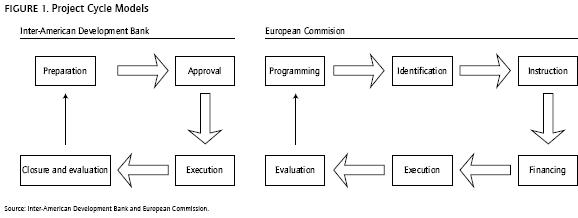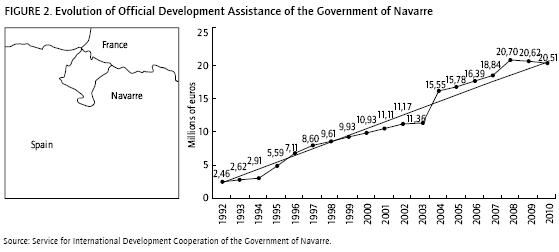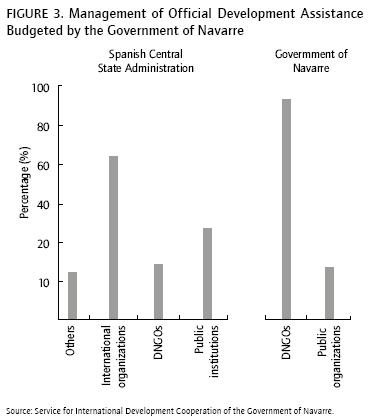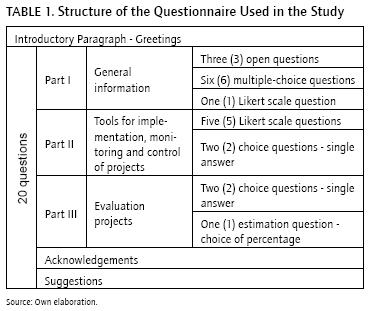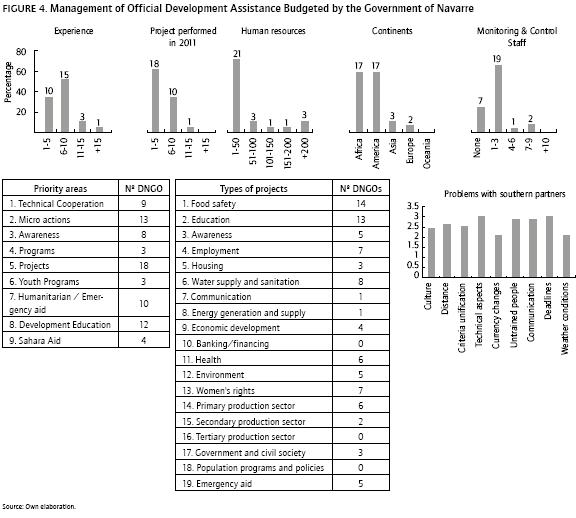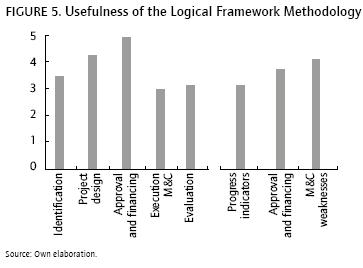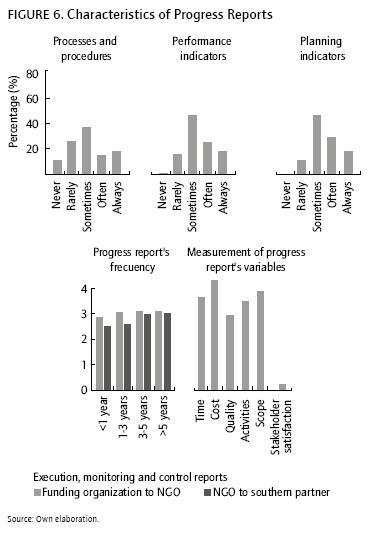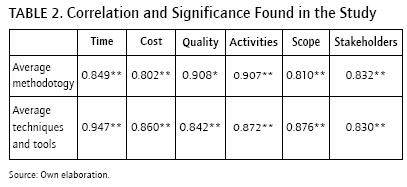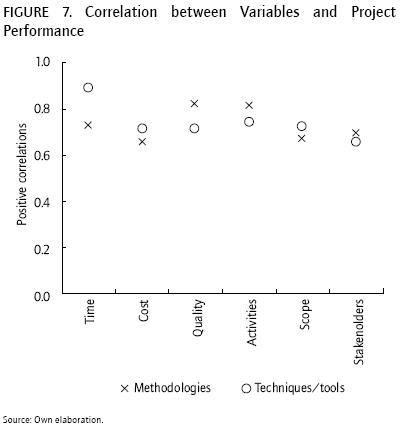Services on Demand
Journal
Article
Indicators
-
 Cited by SciELO
Cited by SciELO -
 Access statistics
Access statistics
Related links
-
 Cited by Google
Cited by Google -
 Similars in
SciELO
Similars in
SciELO -
 Similars in Google
Similars in Google
Share
Innovar
Print version ISSN 0121-5051
Innovar vol.25 no.56 Bogotá Apr./June 2015
https://doi.org/10.15446/innovar.v25n56.48989
DOI: http://dx.doi.org/10.15446/innovar.v25n56.48989.
Project Management in Development Cooperation. Non-Governmental Organizations
Gestión de proyectos y cooperación para el desarrollo en organizaciones no gubernamentales
Gestion de projets et coopération au développement dans les organisations non gouv ernementales.
Gerenciamento de projetos no âmbito da Cooperação para o Desenvolvimento. Organizações não Governamentais
Maricela I. Montes-GuerraI, Aida R. De-MiguelII, M. Amaya Pérez-EzcurdiaIII, Faustino N. Gimena RamosIIII, H. Mauricio Díez-SilvaIIIII
I Ph.D. En Dirección de Proyectos Universidad de la Sabana
Bogotá, Colombia
Correo electrónico: maricela.montes@unisabana.edu.co
II Master en Bienestar Social Universidad Pública de Navarra
Pamplona, España
Correo electrónico: romero.52284@e.unavarra.es
III Ph.D. En Ingeniería Industrial Universidad Pública de Navarra
Pamplona, España
Correo electrónico: amaya@unavarra.es
IIII Ph.D. En Arquitectura Universidad Pública de Navarra
Pamplona, España
Correo electrónico: faustino@unavarra.es
IIIII Ph.D. En Dirección de Proyectos Universidad EAN
Bogotá, Colombia
Correo electrónico: hdiez@ean.edu.co
Correspondencia: Departamento de Proyectos e Ingeniería Rural. Edifício los Tejos, planta baja. Campus Arrosadia. Universidad Pública de Navarra. 31006, Pamplona - España.
Citación: Montes-Guerra, M. I., De-Miguel, A. R., Amaya Perez-Ezcurdia, M., Gimena Ramos, F. N., & Díez-Silva, H. M. (2015). Project Management in Development Cooperation. Non-Governmental Organizations. Innovar, 25(56), 53-68. doi: 10.15446/innovar.v25n56.48989. Enlace doi: http://dx.doi.org/10.15446/innovar.v25n56.48989.
Clasificación JEL: L31, O22, M19.
Recibido: Septiembre 2012, Aprobado: Agosto 2013.
Abstract:
This article analyzes the adoption of project management practices in development cooperation NGOs and their influence on project performance. This paper illustrates the impact in the implementation of methodologies, techniques and tools on outcomes, measured by success criteria of several projects recently implemented. Information from the project managers of the organizations was collected, and complemented by a literature review. We analyzed the correlation among the variables that determine the adoption of a project, and the criteria that determine its success. The positive effect of project management adoption in the performance of cooperation projects is demonstrated, in spite of the low use of methodologies, techniques and tools within the sector. The article shows the importance of project management in cooperation and aid projects, with the purpose of increasing researchers' awareness about the field as applicable knowledge and about the benefits of its use in the sector. The paper shows that project management can improve project efficiency and accountability in other sectors.
Key words: Development cooperation, non-governmental organizations, project management, Spain.
Resumen:
Este artículo analiza la adopción de prácticas propias de la gestión de proyectos en las ONG destinadas a la cooperación para el desarrollo, así como su influencia en la ejecución y el impacto de la aplicación de metodologías, técnicas y herramientas, en los resultados obtenidos por varios proyectos de reciente ejecución. Para tales efectos, se recolectó información de los directores de proyectos de las organizaciones seleccionadas, y adicionalmente se llevó a cabo una revisión de literatura sobre el tema. Con esta información se analizó la correlación entre las variables que determinan la adopción de un proyecto y los criterios que fijan el éxito en su ejecución, demostrando el efecto positivo de la adopción de este enfoque en la realización de proyectos de cooperación, a pesar de la escasa aplicación de las metodologías propuestas.
El documento muestra la importancia de la gestión de proyectos en planes de cooperación y ayuda internacional, y tiene como objetivo incentivar el interés de los investigadores en el área dando a conocer los beneficios de su adopción en el sector. Por último, se demuestra que la aplicación de este enfoque también trae ventajas para el desarrollo de proyectos en otros sectores.
Palabras Clave: Cooperación para el desarrollo, organizaciones no gu-bernamentales, gestión de proyectos, España.
Résumé:
L'article analyse l'adoption par des ONG dédiées à la cooperation au développement de pratiques propres à la gestion de projets, l'influence de l'application de méthodologies, techniques et outils de gestion au cours de la mise en ceuvre des projets, et l'impact sur les résultats obtenus dans plusieurs projets d'execution recente. À cet effet, on a collecté reformation pertinente auprès des directeurs de projets des ONG sélectionnées; on a procédé en outre à une revision de la littérature sur ce thème. Sur cette base on a analyse la correlation entre les variables qui déterminent l'adoption d'un projet et les critères qui assurent la réussite de sa mise en cuvre. L'analyse conclut à l'effet positif de l'adoption de cette approche dans la realisation de projets de cooperation, malgré la faible application des méthodologies proposées. L'article met en évidence l'importance de la gestion de projets dans les plans de coopération et d'aide internationale. Son propos, en exposant les avantages de l'adoption des pratiques de gestion en ce domaine, est de susciter l'intérêt des chercheurs sur ce thème. Enfin, l'article montre que l'application de cette approche peut être béné-fique également pour le développement de projets en d'autres secteurs.
Mots-clés: Cooperation au developpement, ONG, gestion de projets, Espagne.
Resumo:
Este artigo analisa a adoção de práticas de gestão de projetos na área da cooperação para o desenvolvimento, ONGs e a sua influência no desempenho do projeto. O documento ilustra o impacto da aplicação de metodologias tecnicas e ferramentas em resultados medidos por cri-terios de sucesso de vários projetos recentemente implementados. As informações dos gerentes de projetos das organizações foram coletadas e complementadas por uma revisão da literatura. Analisamos a correlação entre as variáveis que determinam a adoção e os criterios que determinam o sucesso de um projeto. O efeito positivo da adoção do projeto de gerenciamento do desempenho dos projetos de cooperação e demonstrado, apesar de um baixo uso de metodologias, tecnicas e ferramentas dentro do setor. O artigo mostra a importância da gestão de projetos em cooperação e de ajuda. Com o objetivo de aumentar a consciência sobre os pesquisadores do campo como aplicável conhecimento, sobre os benefícios de sua utilização no setor, o documento mostra que a gestão do projeto pode melhorar a eficiência do projeto e a prestação de contas em outros setores.
Palavras-chave: Cooperação para o Desenvolvimento, Organizações não Governamentais (ONGs), Gerenciamento de Projetos, Espanha.
Introduction
Project management emerges in the organizational field as the application of knowledge, skills, tools and techniques to meet requirements (Project Management Institute, 2008). During the evolution of this discipline, a large number of techniques were created for its enforcement (Peter WG Morris, 2010). The emergence of professional associations has meant that, since the 60s, organizations have increased their interest in planning project activities, to the extent that standards and bodies of knowledge are applied in most of the world. According to Winter et al. (2006), project management has become an emerging field with a broad academic and professional scope with the need for developing and updating in a regular basis.
In order to assist the standardization and implementation of practices, various tools have been developed by associations such as the Project Management Institute (PMI), the International Project Management Association (IPMA) and the Association for Project Management (APM), among others. According to Morris et al. (2006), bodies of knowledge are emerging frameworks and standards, which contain guidelines and good practices that allow improving skills, training and management for projects.
International aid, official development assistance or development cooperation, is considered one of the sectors where this discipline can show great value. Although traditionally project management has mostly been applied on other areas such as construction, defense and software, among others, the growing importance of aid projects in recipient countries has generated interest for professionals and researchers on its effectiveness in this new type of projects. In this sector, organizations definitely work with projects, and hence in research about the applicability of project management (Ika et al, 2010).
In a general way, development cooperation organizations work with projects and summon many resources, therefore, they stand as a very interesting field for the implementation of practices, learned lessons and methodologies of the discipline. The question addressed in this research is: How can methodologies, techniques and tools of project management be a key factor in project performance and success?
This work analyzes the impact of the adoption of project management techniques and tools on the results of interventions carried out recently by development NGOs. Project performance was analyzed through success criteria from the literature and bodies of knowledge. We aim to enhance the importance of the aid sector as an area of applicability, because of the large number of projects undertaken and their particular purposes. In addition we seek to increase researchers' interest in this sector, as well as analyze and describe the current state of project management in development cooperation.
Theoretical Framework
In order to meet the objectives of this study, the theoretical framework has been structured in two parts: the first is related to the state of the art about project management, success criteria, and how performance can be measured in this field; the second part describes the field of development cooperation and its correlation with projects as a vehicle to run their actions.
Project Management and Performance Measurement
Bodies of knowledge and standards are guidelines developed by associations and organizations, professionals and researchers, that define and validate the conceptual domain and the competencies required for proper performance in the discipline of project management. They contain the most important information (Rozenes et al, 2006); and besides being a guideline, they embrace methods, techniques, tools and skills for those in the line of work (White & Fortune, 2002); these are of voluntary compliance (Hiyassat, 2000), and their adoption as standards or good practices in organizations has increased (Winter et al., 2006); additionally you can find specific literature comparing their orientations (Montes-Guerra et al., 2011; PWG Morris et al, 2006; Wirth & Tryloff, 1995).
Ahlemann et al. (2009) confirm the existence of a large number of standards published by organizations, standardization companies and associations worldwide. Indeed, one effect of standardization is the creation of support tools for the development of the discipline (Garcia, 2005). Milosevic and Patanakul (2005) argue that the increased level of standardization can lead to greater success in project management.
In general, project management is usually carried out with the guidance of bodies of knowledge or standards, and the implementation of a methodology that uses techniques and tools (Shenhar & Dvir, 2007; White & Fortune, 2002). For this reason the adoption of practices should reflect the standard and the application process of techniques or tools. Several studies gather tools and techniques (Besner & Hobbs, 2006; Montes-Guerra et al., 2011); study their application and use in different contexts (Besner & Hobbs, 2006; Díez-Silva et al, 2011; McHugh and Hogan, 2011); or evaluate their use in the industry (Remera et al., 1993).
Other studies examine techniques of common use, such as the earned value analysis (Anbari, 2003; Cioffi, 2006; Lipke et al, 2009; Pajares & Lopez-Paredes, 2011; Plaza & Turetken, 2009); critical path method (Conde, 2009); Gantt chart (Maylor, 2001); the logical framework (Baccarini, 1999; Couillard et al, 2009; Crawford & Bryce, 2003); or the implementation of techniques from organizational areas, such as the Balanced Scorecard (Barclay, 2008; Milis & Mercken, 2004; Niebecker et al, 2010; Norrie & Derek, 2004; Stewart, 2001). It is considered that from the theoretical and practical point of view, tools and techniques incorporate essential elements that, if properly used, can influence results.
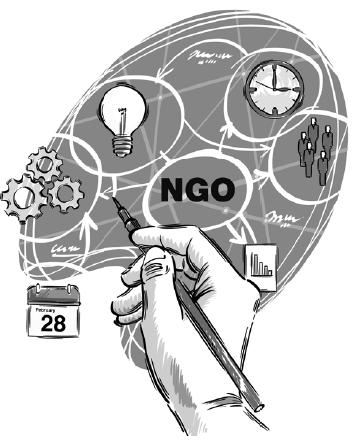
Research supports the same approach on the adoption and application of the discipline's practices in different countries, sectors and organizations (Abbasi & Al-Mharmah, 2000; Ahlemann et al, 2009; Bryde, 2003; Fortune et al, 2011; Ika et al, 2010, McHugh & Hogan, 2011; Muriithi & Crawford, 2003; Murphy & Ledwith, 2007; White & Fortune, 2002). These studies show the high percentage of professionals using methodologies, techniques, tools, or standards as Projects in Controlled Environments (PRINCE2) or Project Management Body of Knowledge (PMBOK). It has been determined that the adoption of project management practices is an important part in the success; but in some sectors, such as development cooperation, must be adapted to the socio-political aspects that influence project outcomes.
With the purpose of analyzing the impact of the adoption of methodologies, techniques and tools on performance, we have studied the normally used criteria to assess performance in projects. In the same way as other management disciplines that use performance measurement, a discussion is established on performance evaluation and its impact on the success of project management (Bryde, 2005). In turn, performance assessment is based on the measurement and monitoring of the project execution criteria (Barclay & Osei-Bryson, 2010), and has traditionally been associated with the variables of time, cost and quality (Pillai et al, 2002; Wi & Jung, 2010).
Project success can be evaluated using three external criteria. First, project management should be taken into account along with other external criteria and long-term expectations. Secondly, the project manager must allow the client to actively contribute in the planning and production phases. Finally, always keep in mind that project success depends on the management techniques used (Munns, 1996). On this matter, different authors have researched the criteria for project success, being management support a common factor mentioned by many and recognized as one of the important factors for a successful development.
It is evident that success measurement is a complex and subjective issue depending on the parties involved. Accordingly, a project can be successful for some and a disaster for others. As a result, objective success indicators should be created for obtaining greater efficiency and transparency. The study of completed projects or conducting an intermediate audit are valuable exercises, not so much to determine in absolute terms, the success or failure, but to indicate the lessons learned for subsequent projects (De Wit, 1988).
Although there is a divergence of views on what constitutes a "successful project" (Prabhakar, 2008), different authors distinguish between project success as measured by the achievement of the objectives, and successful project management usually measured in terms of time, cost and quality (Baccarini, 1999; De Wit, 1988). In this regard, Cooke-Davies (2002) distinguishes between success criteria (measures that the project will be judged by) and success factors (inputs to the management system supporting the success). Project performance is measured by metrics (Luu et al, 2008; Marques et al, 2010), and the process is the establishment of goals, the choice of an improvement strategy through success factors, and the measurement for the difference between what is planned, and the results obtained from that planning (Toor & Ogunlana, 2008, 2010).
Some studies show that it is impossible to have a universal list of criteria, since they vary from one project to another (Jha & Iyer, 2007; Marques et al, 2010). Others suggest to include new dimensions, such as quality management and meeting the expectations of stakeholders (Van Der West-huizen & Fitzgerald, 2005), in order to broaden its perception. In general, most current methods are based on the so-called iron triangle (cost, time and quality) (Wi & Jung, 2010). Other researchers propose some traditional categories and some additional (Almahmoud et al, 2012; Cho et al., 2009; Jha & Iyer, 2007; Ling, 2004; Sohail & Baldwin, 2004). Other approaches suggest different categories to traditional (Cheung et al., 2004; Lauras et al., 2010; Toor & Ogunlana, 2010).
According to Díez-Silva et al. (2011), a total of 22 categories from the literature can be extracted to measure performance in a project, preserving the usual three (time, cost and quality), as well as customer satisfaction, scope, and effort, among others. For the empirical work in this article we used the three traditional categories as success criteria, plus three others taken from the literature and studies related to development cooperation projects. Hence, this research work understands that the performance of projects can be evaluated using a quantification of their success criteria, applying a measurement process that allows qualifying their results over a period of time.
Project Management in Development Cooperation
In the cooperation sector, projects represent the tools to get resources and refer them to the southern countries (Ahsan & Gunawan, 2010; Crawford & Bryce, 2003). They have been characterized for being useful tools and alternatives for bilateral intervention and are often essential to align actions (Ministerio de Asuntos Exteriores y de Cooperación de España, 2009). Some studies suggest that cooperation projects should have strict controls; and tools and techniques should be used to monitor the project progress and project management (Crawford & Bryce, 2003; Ika et al, 2010; Steinfort, 2010; Steinfort & Walker, 2011).
According to the Development Assistance Committee of the Organization for Economic Cooperation and Development (OECD, 1971), official development assistance can be defined as the funds that official agencies, state and local governments or their executive agencies send to developing countries and multilateral institutions. It consists of a complex network where different actors are involved and interact (Crawford & Bryce, 2003; Diallo & Thuillier, 2004; Khang & Moe, 2008); and is channeled through institutions and NGOs of donor countries and aid-receiving countries; and local people (Muriithi & Crawford, 2003). Several aspects make the management of aid a process with and increasing complexity due to the emergence of new scenarios and multiple players (Atienza-Azcona & Itriago, 2009; Seaman, 1999; Torres- Martinez, 2009).
A project in this sector is a proposal of activities organized around a specific objective, to perform in a certain period of time, in a defined geographical area, for a group of beneficiaries, with the aim of solving specific problems or improving a situation. They are a unique type and differ from others, since their objectives are related to a social goal "human development" (Crawford & Bryce, 2003). This feature influences the evaluation of project success, because critical factors have particular connotations (Diallo & Thuillier, 2004; Pinto, 1990), and are related to multidimensional components such as coordination, design, training and institutional environment (Ika et aí, 2010). Besides, the nature of economic assistance and the complex web of stakeholders, hinders the implementation of management tools in the project cycle (Khang & Moe, 2008).
Cooperation studies in project management are scarce, even though many financial resources are used in these interventions (Ahsan & Gunawan, 2010; Crawford & Bryce, 2003). However, the small number of studies available are interesting contributions about the advantages of the discipline application in this sector. This is significant, since management in this type of projects has gathered unified criteria to design, evaluate, approve and plan proposals, but still has weaknesses in implementation processes, so methodologies would be perfect for implementation.
According to steinfort and Walker (2010, 2011), practice management is currently evolving in all areas, including the aid sector. Agencies and governments have released their models and management methods, such as the inter-American Development Bank (IADB), World Bank (WB), European Commission, spanish agency of international development Cooperation (SAIDC), United Nations development Programme (UNDP), swedish international development agency (SIDA), and German technical Cooperation (GTC), among others. many of these have adopted the project cycle model, and each has its own orientation (Landoni & Corti, 2011). Figure 1 shows two examples of management cycle, with similar conceptual approaches that allow a methodology to be adapted easily, particularly in the implementation phase of the project cycle, where greater difficulties are found.
As seen in Figure 1 for both, the inter-American Development Bank and the European Commission (European Commission Cooperation office, EuropeAid, 2004), the execution process of a project is an essential stage. It is considered that most of the discipline practices should be used primarily at this stage, since it is where all actions and efforts take place for development cooperation.
Cooperation projects have different basic requirements, such as: transform reality; solve problems and improve the situation of the beneficiaries; present clearly defined objectives; be addressed to a particular human group; be limited in time and space; provide resources; and ensure their effects endure over time. For those reasons these interventions should seek the highest level of efficiency, and project management is such a great contribution. Donors aim to improve the planning and preparation of projects, as well as the monitoring and evaluation throughout the project life.
in cases like the spanish system of cooperation (Foro de alto nivel sobre la eficacia de la ayuda al desarrollo, 2008), it is intended that the developing countries and donors develop management tools for: effective performance, improving coordination and achieve results, connection between the different players involved, improving budget systems, planning, monitoring and evaluation.
The logical framework methodology can be highlighted as one of the tools that, despite its deficiencies in implementation and management, has enabled the cooperation among stakeholders to use a common language. This approach has been studied by some researchers (Bacca-rini, 1999; Couillard et aí, 2009; Crawford & Bryce, 2003; Khang & Moe, 2008), who found it difficult to integrate with other tools that allow comprehensive management of projects, thus, should be supplemented with additional items and other management systems.
According to Al-Abbasi and Mharmah (2000), the use of this discipline provides an approach that can help developing countries improve the efficiency of projects, and meet their governments' goals, as a method for optimizing resources and improving interventions (stuckenbruck & Zomorrodian, 1987).
Landoni and Corti (2011) consider that cooperative sector organizations could move towards the consolidation of an international standard for managing projects. On this matter, it is considered that a preliminary analysis of the effect of the application of techniques and tools in project management on the results should be performed. It is important to determine the most applicable techniques and tools, with positive impact on the results of development projects. Techniques and tools are considered valuable inputs for further design of methodologies and processes, and the application of procedures, techniques and tools.
According to ika et aí. (2011), a connection can be found between the discipline and the international cooperation sector in terms of project success. There is a positive relation between the use of monitoring and evaluation tools and some project success criteria. It is considered that given the importance of resources for development aid, we must find a mechanism to improve efficiency through the implementation of best practices, and measure the impact of these applications on project results. Therefore the elements to measure project performance are analyzed as a basis for the study presented in this article.
Context Description
Development Cooperation in Navarre, spain (see Figure 2), is planned to address the Millennium Development Goals, working mostly on basic social services (especially health and education). Projects have been carried out in this region for over two decades (1992-2012): a total of 2,544, with a total cost of 238,514,460.17 euros, which has meant a boost for many communities in south America, Central America and Africa, according to the Ministry of Foreign Affairs and Cooperation of spain (Ministerio de Asuntos Exteriores y de Cooperación, 2010).
Figure 2 shows the evolution of the aid, illustrating a progressive increase in the budgets allocated from 2003 to 2011 according to the data provided by the service for international Development Cooperation of the Government of Navarre (Ministerio de Asuntos Exteriores y de Cooperación, 2011). It can also be noted that in recent years, the effect of the crisis has meant budget stagnation.
Today, Navarre is a landmark on international aid financing and development cooperation matters. In 2012, the budget allocated amounted to 16,604,856 euros by the Government of Navarre- international Development Cooperation service (Ministerio de Asuntos Exteriores y de Cooperación de España, 2012), which represents 0.6% of the Government's expenditure budget; which means it is the province with the greatest economic effort made in cooperation throughout the spanish state. The contribution per citizen was 27 euros in 2010 (Ministerio de Asuntos Exteriores y de Cooperación de España, 2010).
When approaching the topic of tools and projects, we can mention they are distributed according to different modalities and sectors: humanitarian (emergency aid and specific humanitarian aid), economic cooperation (micro actions, annual projects, multi-annual programs), technical cooperation (technical assistance projects), development education (awareness raising and education projects), and some others. Aid in Navarre has some characteristic features: it is detached and decentralized, with a good budget that is channeled through NGos and local partners; its management differs from that implemented by the Central Government; and aid is routed through multilateral cooperation, as seen in Figure 3.
It can be seen that the Government of Navarre has contributed greatly to the cooperation sector financing, generating the implementation of a large number of projects in many countries. Management has been carried out in a decentralized way, through the support of management organizations and recipient countries agencies. Therefore, the analysis of the adoption of practices, techniques and project management tools, and their effect on the results of projects, represents a useful contribution to the sector. It is considered that the conclusions drawn from this study may help the large number of NGos that manage resources and execute large projects to improve their procedures and methodologies.
Methodology of the Study
This research aims at determining the use of methodologies, techniques and tools for project management in development cooperation interventions, as well as evaluating the relation between their use and success, following qualitative and quantitative strategies for analysis. We carried out a review and interpretation of literature on issues such as standards, methodologies, techniques and tools, applicability in the sector and benefits produced, and the influence on success criteria or performance.
As it is known, research on project management has the difficulty that projects are unique and heavily influenced by the environmental factors surrounding them. With this work, it has not been intended to perform a study that provides an important level of generalization, but instead, an exploratory analysis that allow researchers to develop strong hypothesis. Quantitative data has not been sought, but rather relationships between variables that can be corroborated in future studies.
With the review and interpretive work in the application of project management within the sector of international cooperation, a descriptive approach is achieved by identifying and analyzing the reason to apply the discipline in cooperation interventions. Once the literature was reviewed, we designed a questionnaire structured in 3 parts and 20 questions, which aims at gathering evidence on the projects and the use of methodology, techniques, tools and software, and their relation with project performance measured by success criteria.
There were 3 open questions, and 17 closed structured as follows: 10 multiple-choice (8 one-only answer and 2 multiple choice options), and 7 estimate (6 of the questions used Likert scale and in 1 percentage had to be chosen according to a recent project performance). The first part, with ten questions, included an overview of the organization, experience, priority areas for intervention, project types, financing, structure, aid receiving countries, funding sources, human resources, personnel involved in the implementation, project monitoring and control, and problems with southern partners.
The second part included seven questions, which gathered information on the use of methodologies, techniques and tools. Likewise, some questions on the logical framework were included, since it is the most widespread methodology in international cooperation. The purpose was to identify the use of methodologies in the life cycle of the project, the usefulness of indicators to measure progress, weaknesses, and their use as a mechanism for approval. Finally, we gathered data on the frequency of application and submission of progress reports according to the size of the project, procedures, use of indicators and measurement of variables for the monitoring and control reports.
The second part of the questionnaire was related to the use of project management methodologies, techniques and tools during the implementation of interventions currently developed by NGOs in Navarre. Results were presented individually, indicating those with a higher range of use. We studied the relation that exists between the use of methodologies and performance in projects. Questions were included to assess the usefulness of the logical framework methodology, and to establish the main weaknesses and whether these influence performance.
We researched about the frequency used by northern organizations for the presentation of progress reports to the project funder, and also, how often these are requested from the southern counterpart, local partner, or executor, in order to determine whether the time intervals are similar. Parameters were established for project time as follows: less than one year, between one and three years, three to five years, more than five years. The category was used equally for all cases to make the relevant comparison. Similarly, with regard to progress reports questions were asked about processes, procedures, indicators measurement and measuring level of project performance variables. With these data, the way of carrying out the monitoring and control of a project was characterized for the type of organizations.
The third and final part consisted of three questions that explored the final performance of a project that has been completed recently. To this end, and based on the literature review, we chose six performance criteria considered relevant in determining success (time, cost, quality, activities, scope and stakeholders' satisfaction), specifically in the context of international aid development cooperation.
The last question of the questionnaire collected information on the completion percentage of a project, using performance measurement variables of success criteria. The variables that determine the performance were linked with the results of the use of project management techniques and tools, establishing any correlation.
The use of the questionnaire is supported as it is considered the most appropriate tool for a qualitative research. The use of techniques such as surveys, based on questionnaires, allows to collect qualitative cohort information, and additionally it facilitates the use of correlation techniques to achieve the purposes of the study.
Before sending the questionnaire to the organizations we selected people with experience in the area of cooperation in order to clarify the language used in questions and improve the understanding of the wording contained therein. We then sent the questionnaire to 188 organizations in Navarre with a record in the databases of the government. A descriptive analysis of the information obtained was performed characterizing the structure of the sector in Navarre, and the organizations that comprise it.
In addition we analyzed the application of project management methodologies, techniques and tools in organizations of the sector in Navarre, describing the adoption in general and determining which have wider applicability. Finally, through a correlation analysis, a connection was established between the application of project management tools and the results of the projects recently run by organizations participating on the survey.
Results Analysis and Discussion
Information collected through the questionnaire provided data, whose analysis focused on various topics of interest, for the purpose of responding to the hypothesis and research question, object of this study. The general information of each organization was classified to characterize the sample by establishing the experience, number of projects developed in 2011, human resources, continents where the actions were addressed, priority areas of intervention and type of projects. The replies to the questionnaire posed the most frequent problems with partners or southern counterparts and the question of whether these problems might influence project performance.
The general information analysis indicates that most organizations, 53%, have experience of 6-10 years, followed by those having 1-5 years, 34%. This indicates that a large proportion has experience and a degree of maturity in project management, facilitating the implementation of the discipline practices in the sector.
The vast majority, represented by 63%, performed between 1-5 projects, and 34% between 6-10 projects during 2011. It is considered that the number executed each year justifies the implementation of tools to improve both the efficiency of the processes and results, taking into account the different characteristics of the sector and the impact of resources invested.
As for the human resources, either partners, employees and volunteers within them, 73% have fewer than 50 people, 11% and 10% have from 51-99 and 200 respectively. These data show that institutions are relatively small, but given the nature of the sector they mobilized a considerable amount of volunteers, who in many cases may be responsible for monitoring and controlling projects. It is worth discussing the implications that this may generate on the implementation of projects in order to improve staff training and in particular volunteers, specifically in project management. Actions are directed primarily to Latin and Central American and Africa, 44% and 43% respectively.
For validating the information on application areas and types of projects, we used the classification made by the Government of Navarre for the approval of funding tenders. The results showed that in terms of priority areas, organizations focus on projects, followed by micro actions and then on development education. These results confirm that it is a sector that has been, and remains, oriented to projects, which are the most common vehicle for development cooperation. As for the type of projects implemented, in the first place are food safety, followed by awareness, water supply and sanitation, among others. There are diverse types of projects, with interventions that focus on all sectors of the economy.
Regarding the staff hired to carry out project monitoring and control, this is small compared with the number of projects implemented each year. This corroborates that these functions may be covered by volunteers, which should be highlighted to organizations, in order to improve volunteers training in project management tools. About the frequency of difficulties presented between volunteers and southern partners, based on a preliminary survey, the data shows that the greatest difficulties arise in meeting deadlines and technical aspects, these two items are strongly related to project performance results because they influence time and scope. Figure 4 shows the overall results of the sample.
As to the methodologies used in the sector, PMBOK is the best known, and while it is used, the percentage of organizations applying it is low, while PRiNCE methodology is the least known. A high proportion of organizations use their own methodologies and logical framework approach, however, these do not have a marked approach to project management. With regard to techniques and tools, the logical framework matrix is the most used, followed by budget control and monitoring, and reporting systems. Some use the GANTT chart and performance indicators, whereas the critical chain and critical path method (CPM) are never used. It can be seen that the use of techniques and tools is low; some organizations do use them, which, as can be seen hereinafter, influences the success of projects.
Concerning the usefulness of the logical framework methodology, interviewees positively assessed it during the stage of approval and financing, but considered it less useful for the execution, monitoring and control. As for the indicators to assess project progress on the Likert scale (1 to 5), the organizations gave an average of 3 (don't disagree -or agree). Therefore, it is considered that the methodology most used in the sector does not have the usefulness required in this process, which justifies the adoption of methodologies, techniques and tools of project management.
Regarding the use of the methodology as a requirement for project approval and financing, organizations showed a general agreement, with an average of 4 (agree). Finally, the majority of organizations showed weaknesses for the monitoring and control process. Figure 5 shows the description of the variables related to the usefulness of the MML, with the results' average.
The replies to the questions about the frequency required for progress reports from the funding organization to the NGO (interviewed), and from the latter to its southern partner, show that the former is more constant than the latter. The methodology used should allow an equal ormore constant relation between the NGO and its southern partner, the latter being the one who runs the project and performs in a more operational level. There is currently no standard schedule for progress reports, which does not allow a controlled coordination of the implementation process. Figure 6 shows the overall results about progress reports.
Regarding progress reports, it was found that the largest proportion of organizations, almost 69%, do not use processes and procedures, or do it sometimes. This indicates that although traditional methodologies such as the logical framework are used, they do not have an application that complements the implementation process. In the same line, 59% of organizations use indicators to measure performance rarely or sometimes. 55% of organizations state that progress reports are subject to the indicators established after financing rarely or sometimes. It is considered that the progress reporting process is not clearly applied, and that the most commonly used methodology, the logical framework, does not show great potential for improving project management.
Performance variables for progress reports show that cost represents the aspect with the highest score (average 4.26), followed by stakeholders satisfaction (average 3.86). It is confirmed that this type of project seeks to meet social objectives, and also comply with the funding agencies. Project scope and quality are less important, although they are two fundamental performance variables. This shows that although this type of project fulfils its fundamental purposes, measurement and management parameters could be broaden in order to improve project management (see Figure 6).
In the last part of the study we analyzed the correlation between variables of project management methodologies, techniques and tools, and performance variables (time, cost, quality, activities, scope and stakeholders' satisfaction). As for the use of methodologies and project performance, a positive correlation can be seen. The most correlated performance variables are quality and activities; the least correlated variables are cost and scope, although their correlation is still positive, this indicates that increasing the use of project management tools improves project performance. Organizations that used project management methodologies have better results in cooperation projects.
On the other hand, in the last section of the study a correlation analysis was conducted to examine the relationship between the most important variables with methodologies, tools and techniques, and the performance of the projects. Table 2 summarizes the correlations of the variables used. For this purpose we used the average rate of those methodologies used by the NGOs and the methodologies used and the average rate of the tools and techniques.
Table 2 shows the relationship between the average rate of methodologies used by NGOs and the fulfilment of success criteria defined for the study. Likewise, the results of the average rate for tools and techniques used in project management in relation to the project success parameters commonly evaluated can be observed as well.
It can be said that by means of increasing the use of methodologies, techniques and tools in the implementation procedures of the projects, the results improve significantly. For the data treatment, the Pearson correlation coefficient was used.
The data in Figure 7 correspond to the determination coefficient, or R2, which shows the values that represent the greatest proximity to the line that crosses the scatter plot of the data collected in the survey. As with the Pearson's coefficient, you can appreciate the relationship between the use of methodologies, techniques and tools in compliance with defined success criteria for the study.
In terms of the use of methodologies of project management by the NGOs, the strongest relationship is found with the criteria of quality and project activities. This corresponds with the fundamental purposes in this type of sector, to give support in all the procedures to fulfill in terms of completion and quality compliance, with certain activities.
In the case of the use of techniques and tools, the stronger relationship is with the criteria of time, followed by the scope. In respect to time, it responds to peculiarities in the discipline. In the first place, is a factor that has a large number of techniques and tools for monitoring and control, it also corresponds as one of the most studied and it is considered as factor of forced compliance and evaluation in any project (iron triangle). similarly, the scope is considered among the most important factors in meeting the criteria for success, whose performance can be improved with the use of techniques and tools.
Regarding the use of techniques and tools, the variable with the highest positive correlation is time, followed by activities and stakeholders' satisfaction. Techniques with the highest positive correlation are the ones related to budget control and monitoring, which mainly influence project time and cost. Another positive correlation technique is risk analysis, which influences time and cost. Organizations that use techniques and tools have better results on variables that determine project performance; in this case on time and cost. For development cooperation projects such as the analyzed, these two variables are crucial, and the use of techniques and tools achieves significant results of improvement. In the case of tools, the most widely used software is the electronic spreadsheet, and there are no other project management computer applications used.
Figure 7 shows the correlations average for project management methodologies, techniques and tools. Positive correlations can be seen as well as the variables where impact is greatest. The positive impact is on the key variables of project management, which corroborates the usefulness of the tools in the discipline. It is found that although the use of these tools is low in projects of development cooperation, the organizations that use them show positive effects on the performance of their interventions, being a highly valuable matter for the general purposes of this sector and the prospect of financing assistance.
This study has attempted to be a pioneer in providing empirical support to reinforce the relationship that exists between the use of monitoring and evaluation tools and some project success criteria. These findings serve to sustain evidence in the literature to suggest that the use of these tools is a key accomplishment factor in the direction of a project.
Conclusions: Relationship Among the Use of Monitoring and Evaluation Tools and Some Project Success Criteria
Development cooperation is a project-oriented sector, since its organizations implement their actions through them. However, it is a complex area due to the large network of agents involved and the particular requirements, which often complicate the process of managing the project life cycle, especially the monitoring and control. To improve the applications in the sector and meet the objectives, it is necessary to use tools that help improve projects efficiency, so that in addition to meeting the social aspects there can be an appropriate management of limited resources.
This is the first study in the area of project management that has examined the rapport between the use of monitoring and evaluation tools and some project success criteria. Evidence has been found about how the utilization of tools in some contexts influences the results of the project. However, it is not intended to accredit this study with a high level of generalization, but instead, as a referent that seeks to detect findings that will allow to formulate hypotheses that might be verified in future studies of the area.
This research provides empirical evidence about the use of methodologies, techniques, tools and software; as well as established procedures for progress reports during the project implementation and execution. It also establishes the relation between the use and final performance in relation to the variables chosen as essential for success. The benefits of using the logical framework methodology as a cooperation tool are confirmed.
Literature on development cooperation and its relation to project management is sparse and inconclusive. There are some inputs regarding management and control tools used in projects in this sector. However, the results of the empirical work showed that project management and its tools directly influence the performance and success of the projects involved.
It was found that in the cooperation sector there is little use of project management tools, although it is know that the use of these can show a positive impact on project performance. This demonstrates the need for bigger efforts to spread the discipline as a means to improve and benefit organizations and agents involved in cooperation. Organizations positively valued the logical framework methodology for the planning and project financing process, however it was found that it presents some weaknesses and results not being useful for the execution, monitoring and control processes. This opens the opportunity for the weaknesses to be minimized through project management and tools.
Generally, it was concluded that there is little knowledge of methodologies, techniques and tools in the cooperation sector, although some organizations make use of them, and that positively influences project performance. Project management should be a complement to existing logical models which have allowed the standardization of criteria when planning the actions, but depict weaknesses when assessing their own management and implementation. The application of project management in the aid sector is a process that benefits all the parts involved, allowing a more lasting and sustainable development.
Empirical work shows that the use of project management tools has a high impact on key variables for development projects performance such as quality and activities. It is therefore important to integrate methodologies, techniques and tools in the implementation of these projects. We propose to extend the range of measuring variables to the field of management in order to gather data in a system of performance measurement.
Taking the agents involved in a project as a reference, two lines of future action are proposed. On the one hand, the development of a methodology for public use in the cooperation sector that includes the requirements of all the agents involved in the process and identifies the needs for each one. On the other hand, an improvement in the design of this methodology and its planning that can cover the needs of this type of projects to ensure better monitoring and control of interventions, improve the aid efficiency and facilitate all agents' accountability is also proposed.
It is considered that the methodology used to prepare the study is useful in project management contexts and provides a procedure that allows an adequate analysis, data processing and results presentation, both interpretively and graphically. It is suggested that the methodology could be used in similar studies to relate the success factors in a project to its performance and outcome.
References
Abbasi, G. Y., & Al-Mharmah, H. (2000). Project management practice by the public sector in a developing country. International Journal of Project Management, 18(2), 105-109. [ Links ]
Ahlemann, F., Teuteberg, F., & Vogelsang, K. (2009). Project Management standards - Diffusion and Application in Germany and switzerland. International Journal of Project Management, 27(3), 292-303. [ Links ]
Ahsan, K., & Gunawan, I. (2010). Analysis of Cost and schedule Performance Of international Development Projects. International Journal of Project Management, 28(1), 68-78. [ Links ]
Almahmoud, E.S., Doloi, H.K., & Panuwatwanich, K. (2012). Linking Project Health to Project Performance indicators: Multiple Case studies of Construction Projects in saudi Arabia. International Journal of Project Management, 30(3), 296-307. [ Links ]
Anbari, F.T. (2003). Earned Value Project Management Method and Extensions. Project Management Journal, 34(4), 12-23. [ Links ]
Atienza-Azcona, J., & Itriago, D. (2009). Ayuda española: avances y retos pendientes para el periodo 2009 -2012. Foro AOD. [ Links ]
Baccarini, D. (1999). The Logical Framework Method for Defining Project success. Project Management Journal, 30(4), 25-32. [ Links ]
Barclay, C. (2008). Towards an integrated Measurement of is Project Performance: The Project Performance scorecard. Information Systems Frontiers, 10(3), 331-345. [ Links ]
Barclay, C., & Osei-Bryson, K.M. (2010). Project Performance Development Framework: An Approach for Developing Performance Criteria & Measures for information systems (is) Projects. International Journal of Production Economics, 124(1), 272-292. [ Links ]
Besner, C., & Hobbs, B. (2006). The Perceived Value and Potential Contribution of Project Management Practices to Project success. Project Management Journal, 37(6), 37-48. [ Links ]
Bryde, D.J. (2003). Project Management Concepts, Methods and Application. International Journal of Operations & Production Management, 23(7), 775-793. [ Links ]
Bryde, D. J. (2005). Methods for Managing Different Perspectives of Project success. British Journal of Management, 16(2), 119-131. [ Links ]
Cheung, S.O., Suen, H.C.H., & Cheung, K.K.W. (2004). PPMs: A Web-based Construction Project Performance Monitoring system. Automation in Construction, 13(3), 361-376. [ Links ]
Cho, K., Hong, T., & Hyun, C. (2009). Effect of Project Characteristics On Project Performance in Construction Projects Based on structural Equation Model. Expert Systems with Applications, 36(7), 10461-10470. [ Links ]
Cioffi, D. F. (2006). Designing project management: A scientific notation and an improved Formalism for Earned Value Calculations. International Journal of Project Management, 24(2), 136-144. [ Links ]
Comisión Europea Oficina de Cooperación (EuropeAid). (2004). Manual de Gestión del Ciclo del Proyecto. [ Links ]
Conde, E. (2009). A Minmax Regret Approach to the Critical Path Method with Task interval Times. European Journal of Operational Research, 197, 235-242. [ Links ]
Cooke-Davies, T. (2002). The "Real" success Factors on Projects. International Journal of Project Management, 20(3), 185-190. [ Links ]
Couillard, J., Garon, S., & Riznic, J. (2009). The Logical Framework Approach - Millennium. Project Management Journal, 40(4), 31-44. [ Links ]
Crawford, P., & Bryce, P. (2003). Project monitoring and evaluation: a method for enhancing the efficiency and effectiveness of aid project implementation. International Journal of Project Management, 21 (5), 363-373. [ Links ]
De Wit, A. (1988). Measurement of Project success. International Journal of Project Management, 6(3), 164-170. [ Links ]
Diallo, A., & Thuillier, D. (2004). The success Dimensions of international Development Projects: The Perceptions of African Project Coordinators. International Journal of Project Management, 22, 19-31. [ Links ]
Diallo, A., & Thuillier, D. (2005). The success of international Development Projects, Trust and Communication: An African Perspective. International Journal of Project Management, 23, 237-252. [ Links ]
Díez-Silva, H.M., Pérez-Ezcurdia, M.A., Gimena-Ramos, F.N., & Montes-Guerra, M.I. (2011). Performance indicators in Project Management Processes. Case study of Public sector in Colombia. In XV international Congress on Project Engineering (Ed.), Asociación Española de Ingeniería de Proyectos - AEIPRO, International Project Management Association - IPMA. Huesca (España). [ Links ]
Foro de alto nivel sobre la eficacia de la ayuda al desarrollo (2008). Declaración en Accra. Ghana. [ Links ]
Fortune, J., White, D., Jugdev, K., & Walker, D. (2011). Looking Again at Current Practice in Project Management. International Journal of Managing Projects in Business, 4(4), 553-572. [ Links ]
Garcia, S. (2005). How standards Enable Adoption of Project Management Practice. IEEE Software, 22(5), 22-29. [ Links ]
Gobierno de Navarra. Servicio de Cooperación internacional al Desarrollo. (2011). Ii Plan Director de la Cooperación Navarra (2011 - 2014). Pamplona. [ Links ]
Gobierno de Navarra. Servicio de Cooperación internacional al Desarrollo. (2012). Plan Operativo Anual de Cooperación. [ Links ]
Hiyassat, M.A.S. (2000). Applying the ISO standards to a Construction Company: A Case study. International Journal of Project Management, 18(4), 275-280. [ Links ]
Ika, L.A., Diallo, A., & Thuillier, D. (2010). Project Management in the international Development Industry. The Project Coordinator's Perspective. International Journal of Managing Projects in Business, 3(1), 61-93. [ Links ]
Ika, L.A., Diallo, A., & Thuillier, D. (2011). The Empirical Relationship Between success Factors and Dimensions. The Perspective of World Bank Project supervisors and Managers. International Journal of Managing Projects in Business, 4(4), 711-719. [ Links ]
Jha, K. N., & Iyer, K. C. (2007). Commitment, Coordination, Competence and the iron Triangle. International Journal of Project Management, 25(5), 527-540. [ Links ]
Khang, D.B., & Moe, T.L. (2008). Success Criteria and Factors for international Development Projects: A Life-Cycle-Based Framework. Project Management Journal, 39(1), 72-84. [ Links ]
Landoni, P., & Corti, B. (2011). The Management of international Development Projects: Moving Toward a standard Approach or Differentiation? Project Management Journal, 42(3), 45-61. [ Links ]
Lauras, M., Marques, G., & Gourc, D. (2010). Towards a Multi-Dimensional Project Performance Measurement system. Decision Support Systems, 48(2), 342-353. [ Links ]
Ling, F.Y.Y. (2004). How Project Managers Can Better Control The Performance of Design- Build Projects. International Journal of Project Management, 22(6), 477-488. [ Links ]
Lipke, W., Zwikael, O., Henderson, K., & Anbari, F. (2009). Prediction of Project Outcome: The application of statistical Methods to Earned Value Management and Earned schedule Performance indexes. International Journal of Project Management, 27(4), 400-407. [ Links ]
Luu, V.T., Kim, S.Y., & Huynh, T.A. (2008). Improving Project Management Performance of Large Contractors Using Benchmarking Approach. International Journal of Project Management, 26(7), 758-769. [ Links ]
Marques, G., Gourc, D., & Lauras, M. (2010). Multi-criteria Performance Analysis for Decision Making in Project Management. International Journal of Project Management, In Press, Corrected Proof. [ Links ]
Maylor, H. (2001). Beyond the Gantt chart: Project Management Moving On. European Management Journal, 19(1), 92-100. [ Links ]
McHugh, O., & Hogan, M. (2011). Investigating the Rationale For Adopting an internationally-recognised Project Management Methodology in ireland: The View of the Project Manager. International Journal of Project Management, 29(5), 637-646. [ Links ]
Milis, K., & Mercken, R. (2004). The Use of the Balanced scorecard for the Evaluation of information and Communication Technology Projects. International Journal of Project Management, 22(2), 87-97. [ Links ]
Milosevic, D., & Patanakul, P. (2005). Standardized Project Management May increase Development Projects success. International Journal of Project Management, 23(3), 181-192. [ Links ]
Ministerio de Asuntos Exteriores y de Cooperación de España (2010). Plan Anual de Cooperación Internacional PACI 2010: Secretaria de Estado de Cooperación Internacional. Dirección General de Planificación y Evaluación de Políticas para el Desarrollo. [ Links ]
Ministerio de Asuntos Exteriores y de Cooperación de España (2009). Plan Director de la Cooperación Española 2009-2012. España: AECID. [ Links ]
Montes-Guerra, M.I., Gimena-Ramos, F. N., Pérez-Ezcurdia, M.A., & Díez-Silva, H. M. (2011). Exploring Project Management Bodies of Knowledge and Monitoring & Control Orientation. In XV international Congress on Project Engineering (Ed.), Asociación Española de Ingeniería de Proyectos - AEIPRO, International Project Management Association - IPMA. Huesca (España). [ Links ]
Morris, P.W.G. (2010). Research and the Future of Project Management. International Journal of Managing Projects in Business, 3(1), 139-146. [ Links ]
Morris, P.W.G., Crawford, L., Hodgson, D., Shepherd, M.M., & Thomas, J. (2006). Exploring the Role of Formal Bodies of Knowledge in Defining a Profession - The Case of Project Management. International Journal of Project Management, 24(8), 710-721. [ Links ]
Munns, A.K., & Bjeirmi, B.F. (1996). The Role of Project Management in Achieving Project success. International Journal of Project Management, 14(2), 81-87. [ Links ]
Muriithi, N., & Crawford, L. (2003). Approaches to Project Management in Africa: implications for international Development Projects. International Journal of Project Management, 21 (5), 309-319. [ Links ]
Murphy, A., & Ledwith, A. (2007). Project Management Tools and Techniques in High-Technology sMEs. Management Research News, 30(2), 153-166. [ Links ]
Niebecker, K., Eager, D., & Moulton, B. (2010). Collaborative and Cross-company Project Management Within the Automotive industry Using the Balanced scorecard. International Journal of Managing Projects in Business, 3(2), 328-337. [ Links ]
Norrie, J., & Derek, H.T.W. (2004). A Balanced scorecard Approach to Project Management Leadership. Project Management Journal, 35, 47-56. [ Links ]
OCDE (1971). Organización para la Cooperación y el Desarrollo Económico. Comité de Ayuda al Desarrollo (CAD). [ Links ]
Pajares, J., & López-Paredes, A. (2011). An Extension of the EVM Analysis for Project Monitoring: The Cost Control index and the schedule Control index. International Journal of Project Management, In Press, Corrected Proof. [ Links ]
Pillai, A.S., Joshi, A., & Rao, K.S. (2002). Performance Measurement of R&D Projects in a Multi-project, Concurrent Engineering Environment. International Journal of Project Management, 20(2), 165-177. [ Links ]
Pinto, J.K. (1990). Project implementation Profile: A Tool to Aid Project Tracking and Control. International Journal of Project Management, 8(3), 173-182. [ Links ]
Plaza, M., & Turetken, O. (2009). A Model-based Dss for integrating the impact of Learning in Project Control. Decision Support Systems, 47(4), 488-499. [ Links ]
Prabhakar, G.P. (2008). What is Project success: A Literature Review. International Journal of Business and Management, 3(9), 3-10. [ Links ]
Project Management institute (2008). A guide to the Project Management Body of Knowledge. Fourth Edition, PMBOKR. Newtown square, Pennsylvania (USA). [ Links ]
Remera, D.S., Stokdykb, S.B., & Van Driel, M. (1993). Survey of Project Evaluation Techniques Currently Used in industry. International Journal of Production Economics, 32, 103-115. [ Links ]
Rozenes, S., Vitner, G., & Spraggett, S. (2006). Project Control: Literature Review. Project Management Journal, 37(4), 5-14. [ Links ]
Seaman, J. (1999). Malnutrition in Emergencies: How Can We Do Better and Where Do the Responsabilities Lie? Disasters, 23(4), 306-315. [ Links ]
Shenhar, A.J., & Dvir, D. (2007). Project Management Research: The Challenge and Opportunity. Project Management Journal, 38(2), 93-99. [ Links ]
Sohail, M., & Baldwin, A. N. (2004). Performance indicators for 'Micro-projects' in Developing Countries. Construction Management and Economics, 22(1), 11-23. [ Links ]
Steinfort, P. (2010). Understanding the Antecedents of Project Management Best Practice-lessons to be Learned from Aid Relief Projects. Unpublished Ph.D. Tesis, RMIT University, Melbourne. [ Links ]
Steinfort, P., & Walker, D.H.T. (2011). What Enables Project Success: Lessons from Aid Relief Projects. Newtown square, PA: Project Management institute. [ Links ]
Stewart, W.E. (2001). Balanced scorecard for Projects. Project Management Journal, 32(1), 38-53. [ Links ]
Stuckenbruck, L.C., & Zomorrodian, A. (1987). Project Management: the Promise for Developing Countries. International Journal of Project Management, 5(3), 167-175. [ Links ]
Toor, s.U.R., & Ogunlana, s.O. (2008). Critical COMs of success in Large-scale Construction Projects: Evidence from Thailand Construction industry. International Journal of Project Management, 26(4), 420-430. [ Links ]
Toor, S.U.R., & Ogunlana, S. O. (2010). Beyond the 'Iron triangle': Stakeholder Perception of Key Performance indicators (KPIS) for Large-scale Public sector Development Projects. International Journal of Project Management, 28(3), 228-236. [ Links ]
Torres- Martinez, A.J. (2009). Los Factores de Viabilidad de los Proyectos y Programas de Desarrollo en el sector de las infraestructuras. Universidad Politécnica de Valencia, Servicio de Publicación. [ Links ]
Van Der Westhuizen, D., & Fitzgerald, E.P. (2005). Defining and Measuring Project success. In D. Remenyi (Ed.), European Conference on IS Management, Leadership and Governance (pp. 157-163). Reading, United Kingdom: Academic Conferences Limited. [ Links ]
White, D., & Fortune, J. (2002). Current Practice in Project Management -An Empirical study. International Journal of Project Management, 20(1), 1-11. [ Links ]
Wi, H., & Jung, M. (2010). Modeling and Analysis of Project Performance Factors in an Extended Project-oriented Virtual Organization (EPROVO). Expert Systems with Applications, 37(2), 1143-1151. [ Links ]
Winter, M., Smith, C., Morris, P., & Cicmil, S. (2006). Directions for Future Research in Project Management: The Main Findings of a UK Government- funded Research Network. International Journal of Project Management, 24(8), 638-649. [ Links ]
Wirth, I., & Tryloff, D. E. (1995). Preliminary Comparison of six Efforts to Document the Project-management Body of Knowledge. International Journal of Project Management, 13(2), 109-118. [ Links ]













